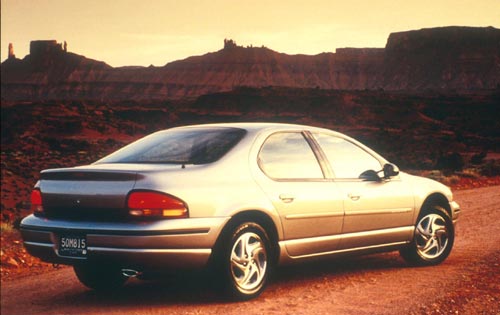1995-2000 Dodge Stratus ES

1996 Dodge Stratus ES
The Stratus was Dodges’ answer to Ford’s Contour in the mid-sized sedan segment for most of the 90’s. It’s cab forward design was both sporty and clunky looking at the same time. Resembling a rhino with it many bulges, it was one of the first applications of the signature Dodge cross bar grille in a midsized sedan. The thick C pillar and built-in rear spoiler gave the car an aggressive and substantial look that might have been more at home on a Dodge truck than a mainstream family sedan.
Chrysler’s JA platform was shared by nearly all its divisions, except for Jeep. The Chrysler Cirrus and Plymouth Breeze were up and down market versions of the Stratus respectively. The Stratus was sold in Mexico, Europe and later the second generation would be produced under license in Russia. The Stratus was the most popular of the JA cars, at times out selling the lower priced and smaller Neon. At its initial introduction the car was praised by the media, noting the performance of the 2.5 L V6 in the ES model. Most cars sold came with either a 2.0 or 2.4 SOHC 4 cylinder engine from the Neon.
In the heavier Stratus, the smaller engines seemed underpowered. All cars no matter what version
featured a fully independent double wishbone suspension, a key element it the praise the Stratus received for its roadholding abilities. The sportier ES versions came with an optional Autostick transmission, otherwise they used the standard four-speed automatic. At 168 hp, the ES’s 2.5 L V6 was no rocket, but when matched with the Autostick transmission it became a mildly fun to drive car with sporty road manners. A five-speed manual was available, but only for the 2.0 L engine. In Mexico you could buy a turbocharged version using the Neon’s 2.4 DOHC.
The Stratus was innovative and slightly ahead of the market,when introduced. Most of the competition, especially domestic, were still using cross beam rear suspensions, while the Stratus used the more Honda like double wishbone independent. To buyers taking a test drive, the
handling and ride quality were far ahead of the typical domestic mid-sized sedan. The competition advanced more rapidly than the Stratus as interest from the public and sales seemed to diminished as exterior changes were few and no major changes made the Stratus less competitive.
The mid-sized sedan market was very competitive in America at the time with many of the contenders very close in price and features. Chrysler tried to address issues with the old car when a new redesigned Stratus appeared in 2001. The design was no longer distinctive, but it was overall
better engineered. Sadly, sales never seemed to match those of the first generation car.
Chevy, Toyota and even Ford had made great strides in quality (at the cost of design distinctiveness) and all of them saw increased sales. The Stratus endured, but in hindsite what now looks like desperate marketing the Stratus name may have confused buyers. A two door formally wearing the Avenger name was now a Stratus. Coupe and sedan sales together could not match heyday sales of the first Stratus sedans. These cars were popular with fleet and rental agency’s because they were dependable
and easy to buy (cheap) and to maintain. Today they are the mainstays of urban car lots across the country and represent a good value if you can find one that did not spend the first half of its life as an abused rental.

1996 Dodge Stratus ES
